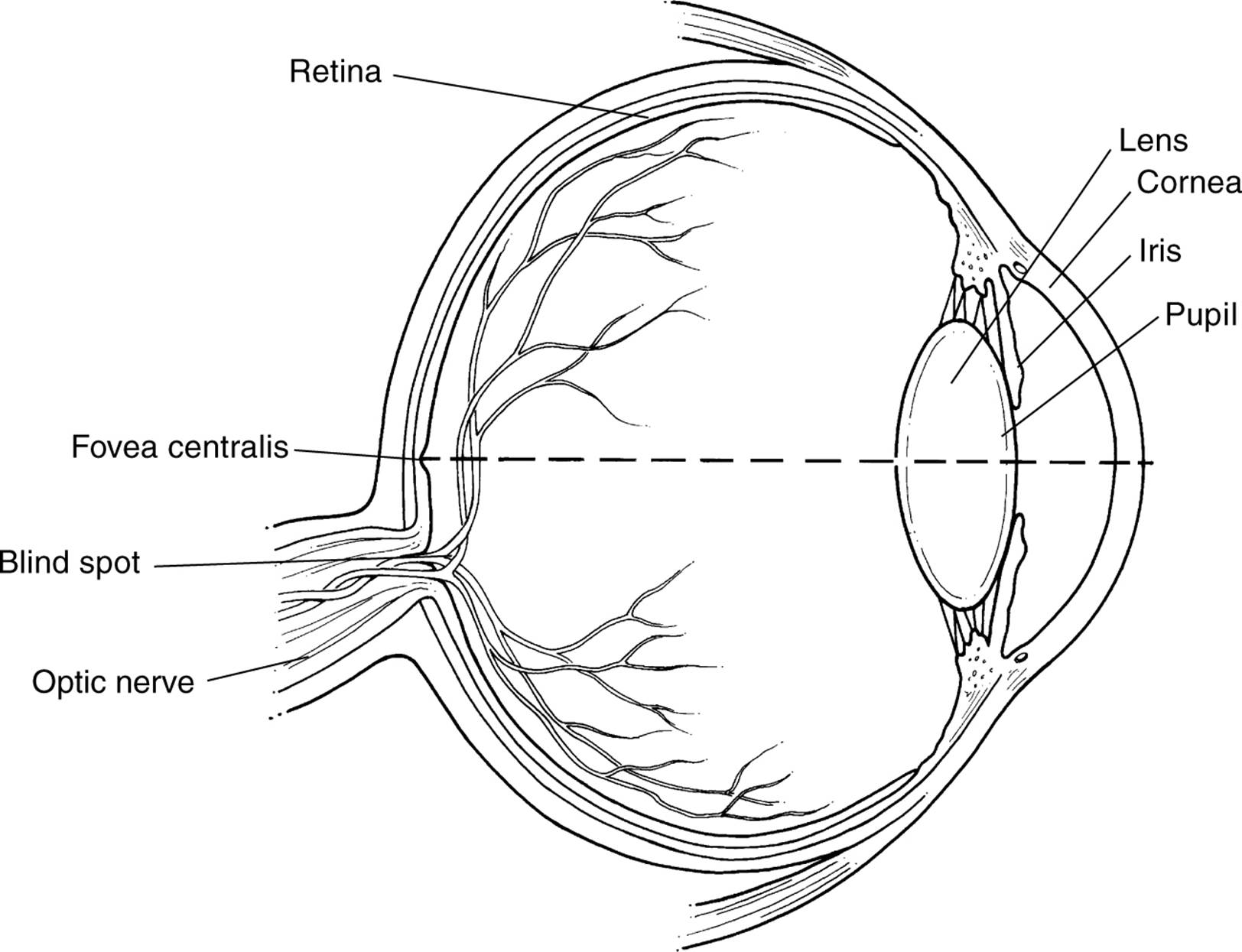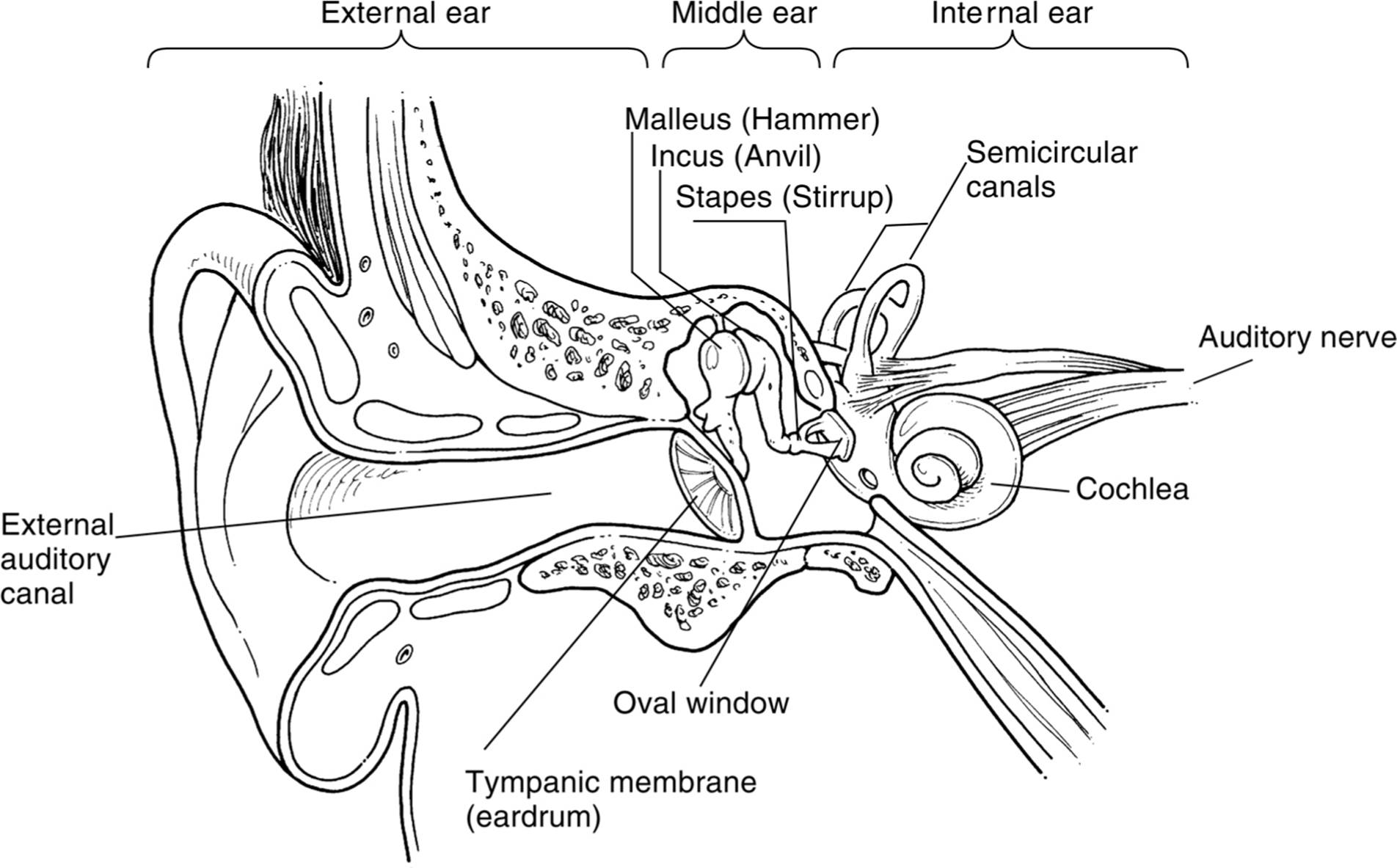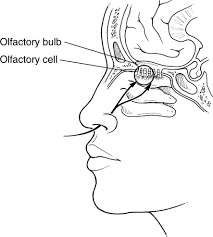chapter 4: sensation and perception
overview
- our sensory organs receive stimuli and these messages go through a process called transduction
- transduction - the signals are transformed into neural impulses, which travel to the thalamus and then to other cortices of the brain
- sensory adaptation - decreasing responsiveness to stimuli due to constant stimulation
- sensory habituation - our perception of sensations is partially due to how focused we are on them
- cock-tail party phenomenon - the ability to focus one's attention on a particular stimulus while filtering out a range of other stimuli
vision
- vision is the dominant sense in human beings
- the process of vision involves several steps
step one: gathering light
light is reflected off objects and gathered by the eye
the color we perceive depends on several factors
- light intensity: describes how much energy the light contains and determines how bright the object appears
- light wavelength: determines the particular hue we see. we see different wavelengths within the light spectrum as colors.
- when you mix all the colors you would get white light or sunlight.
- objects appear the color they do as a result of the wavelengths of light they reflect.
- objects appear black because they absorb all colors and white because they reflex all wavelengths of light
- wavelengths longer than visible light are infrared waves, microwaves, and radio waves. wavelengths shorter than visible light are ultraviolet waves and X-rays.

step two: within the eye
- reflected light first enters the eye through the cornea.
- cornea - a protective covering and helps focus the light
- then, the light goes through the pupil
- pupil - when it’s opened or dilated by the iris, it lets more light in, and when it’s smaller, it lets less light in
- iris - the muscles that control the pupil
- accommodation - light that enters the pupil is focused by the lens
- lens - is curved and flexible in order to focus the light
- as the light passes through the lens, the image is flipped upside down and inverted, which projects on the retina
- retina - acts as a screen on the back of your eye and contains specialized neurons that are activated by different wavelengths of light
step three: transduction
- transduction - refers to the translation of incoming stimuli into neural signals. not only does it apply to vision, but to all senses.
- transduction occurs when light activates neurons in the retina.
- there are several layers of cells in the retina. the first layer of cells is activated by light, and there are two types of cells: cones and rods
- cones - cells that are activated by color
- rods - cells that are activated by black and white
- rods outnumber cones and are distributed throughout the retina
- cones are towards the center of the retina
- fovea - an indentation at the very center of the retina that contains the highest concentration of cones
- if enough rods and cones fire in an area of the retina, they activate the next layer of bipolar cells
- if enough of these cells fire, the next layer of cells is activated
- ganglion cells - the next layer of cells after bipolar cells
- the axons of these cells make up the optic nerve that sends impulses to a specific region in the thalamus called the lateral geniculate nucleus
- from this area, the messages are sent to the visual cortices
- the spot where the optic nerve leaves the retina does not have any rods or cones, so it’s referred to as the blind spot
- the optic nerve has two parts
- impulses from the left side of each retina go to the left hemisphere of the brain while impulses from the right side of each retina go to the right hemisphere of the brain
- optic chiasm - the spot where the nerves cross each other
step four: in the brain
- the visual cortex of the brain receives impulses from the cells of the retina and the impulses activate detectors
- perception researchers David Hubel and Torsten Wiesel discovered that groups of neurons in the visual cortex respond to different types of visual images
- the visual cortex has detectors for vertical lines, curves, motion, and others.
trichromatic theory
- trichromatic theory - the oldest and most simple theory that hypothesized that we have three types of cones in the retina: cones that detect the different colors blue, red, and green
- these cones are activated in different combinations and produce all the colors of the visible spectrum
- this theory can’t explain some visual phenomena, such as afterimages or color blindness
- afterimages - when you look at a color for a while and you look at a white background, these pop up
- color blindness - individuals cannot see either red/green shades or blue/yellow shades, and in other cases, people can only see shades of gray
opponent-process theory
opponent-process theory - states that the sensory receptors arranged in the retina come in pairs; red/green pairs, yellow/blue pairs, and black/white pairs
if one sensor is stimulated, its pair would be inhibited from firing
this theory explains color afterimages since if you stare at one color for a while, you would fatigue the sensors for that color and would see its pair instead
this theory also explains color blindness, because if color sensors come in pairs and someone is missing a pair, they would have difficulty seeing the missing hues

hearing
- auditory senses also use energy in the form of waves. however, sound waves are vibrations in the air rather than electromagnetic waves
- sound waves travel through the air and are collected by our ears
- the vibrations go through the process of transduction into neural messages and are sent to the brain
- sound waves have amplitude and frequency
- amplitude - the height of the wave and determines the loudness of the sound, which is measured in decibels
- frequency - refers to the length of the waves and determines pitch, measured in megahertz.
- high-pitched sounds would have high frequencies and are packed together, while low-pitched sounds would have low frequencies and are spaced apart
- sound waves are collected in the outer ear (pinna) and travel down the ear canal until they reach the eardrum
- eardrum - a thin membrane that vibrates as the sound waves hit it
- the eardrum is connected to the hammer which is connected to the anvil which is connected to the stirrup
- the vibrations of the eardrum are transmitted by these three bones to the oval window
- oval window - a membrane very similar to the eardrum and is attached to the cochlea
- cochlea - a structure shaped like a snail’s shell filled with fluid
- as the oval window vibrates, the fluid moves
- basilar membrane - the floor of the cochlea lined with hair cells connected to the organ of Corti
- organ of Corti - neurons activated by the movement of the hair cells
- when the fluid moves, the hair cells move, and transduction occurs. the organ of Corti fires and impulses are transmitted to the brain
place theory
- place theory - holds that the hair cells in the cochlea respond to different frequencies of sound based on where they are located in the cochlea
- we sense pitch because the hair cells move in different places in the cochlea
frequency theory
- place theory accurately describes how hair cells sense the upper range of pitches but not the lower range
- lower tones are sensed by the rate at which the cells fire, so we send pitch because the hair cells fire at different rates (frequencies) in the cochlea
deafness
- conduction deafness - occurs when something goes wrong with the system of conducting the sound to the cochlea
- nerve deafness - occurs when the hair cells in the cochlea are damaged, usually by loud noise
touch
our sense of touch is activated when our skin is indented, pierced, or experiences a change in temperature
some nerve endings in our skin respond to pressure while others respond to temperature
if touch or temperature receptors are stimulated sharply, a different kind of nerve ending called pain receptors will also fire
gate control theory - explains that some pain messages have a higher priority than others
when a higher priority message is sent, the gate swings open for it and swings shut for a low priority message
- example: when you scratch an itch, the gate swings open for your high-intensity scratching and shut for the low-intensity itching, and you stop the itching for a short period of time

taste (or gustation)
taste buds are located on papillae
papillae - the bumps you can see on your tongue
humans sense five different types of tastes: sweet, salty, sour, bitter, and umami (savory)
the more densely packed the taste buds, the more chemicals are absorbed, and the more intensely the food is tasted

smell (or olfaction)
- molecules of substances rise into the air and some are drawn into our nose
- the molecules settle in a mucous membrane at the top of each nostril and are absorbed by the receptor cells there
- these cells are linked to the olfactory bulb
- olfactory bulb - gathers the messages from the olfactory receptor cells and sends this information to the brain
- the nerve fibers from the olfactory bulb connect to the brain at the amygdala and then to the hippocampus, which makes up the limbic system
- limbic system - responsible for emotional impulses and memory
vestibular sense
- our vestibular sense tells us about how our body is oriented in space
- three canals in the inner ear give the brain feedback about body orientation
- these canals are tubes partially filled with fluid
- when your head moves, the flood moves in the canals, causing sensors in the canals to move. the movement of these hair cells activates neurons and their impulses go to the brain
kinesthetic sense
- our kinesthetic sense gives us feedback about the position and orientation of specific body parts
- receptors in our muscles and joints send information to our brain about limbs, which lets us keep track of our body
perception
- psychophysics - the study of the interaction between the sensations we receive and our experience of them
thresholds
- senses have limits
- absolute threshold - the smallest amount of stimulus we can detect
- example: the absolute threshold for vision is the smallest amount of light we can detect
- stimuli below our absolute threshold are said to be subliminal
- difference threshold - the smallest amount of change needed in a stimulus before we can detect a change
- Weber’s law computed this, named after Ernst Weber
- the difference threshold states that the change needed is proportional to the original intensity of the stimulus. the more intense the stimulus the more it will need to change before we notice a difference
- Weber discovered that each sense varies according to a constant, but the constants different between the senses
signal detection theory
- signal detection theory - investigates the effects of the distractions and interference we experience while perceiving the world
- these factors together are called response criteria or receiver operating characteristics
- false positive - when we think we perceive a stimulus that is not there
- false negative - not perceiving a stimulus that is present
top-down processing
- top-down processing - we perceive by filling in gaps in what we sense, occurs when you use your background knowledge to fill in gaps in what you perceive
- this creates schemata
- schemata - mental representations of how we expect the world to be
- schemata can create a perceptual set
- perceptual set - a predisposition to perceive something in a certain way
- an example of this is backmasking, where there were supposed hidden messages musicians recorded backward in their music
- in reality, this was just random noise
bottom-up processing
bottom-up processing (or feature analysis) - the opposite of top-down processing. instead of using our experience to perceive an object, we use only the features of the object itself to build a complete perception
top-down processing is faster but more prone to error, while bottom-up processing takes longer but is more accurate

principles of visual perception
- figure-ground relationship - what part of a visual image is the figure and what part is the ground or background?
- the optical illusion above uses this rule
Gestalt rules
- a group of Gestalt psychologists described the principles that govern how we perceive groups of objects and pointed out that we normally perceive images as groups, not as isolated elements
- proximity: objects that are close together are more likely to be perceived as belonging to the same group
- similarity: objects that are similar in appearance are more likely to be perceived as belonging to the same group
- continuity: objects that form a continuous form are more likely to be perceived as belonging to the same group
- closure: similar to top-down processing. objects that make up a recognizable image are more likely to be perceived as belonging to the same group even if the image contains gaps that the mind needs to fill in
constancy
- constancy - our ability to maintain a constant perception of an object despite changes/variation
- size constancy: objects closer to our eyes will produce images on our retinas, but we take distance into account in our estimations of size. we keep a constant size in mind for an object and know that it does not grow or shrink in size as it moves closer or farther away
- shape constancy: objects viewed from different angles will produce different shapes on our retinas but we know the shape of an object remains constant. this depends on our familiarity with the usual shape of the object
- brightness constancy: we perceive objects as being a constant color even as the light reflecting off the object changes
perceived motion
- our brains are able to detect how fast images move across our retinas and to take into account our own movement
- stroboscopic effect - images in a series of still pictures presented at a certain speed will appear to be moving
- phi phenomenon - a series of lightbulbs turned on and off at a particular rate will appear to be one moving light
- autokinetic effect - if a spot of light is projected steadily onto the same place on a wall of a dark room and people are asked to stare at it, they will say that it’s moving
depth cues
- without depth perception, we would view the world as a 2D flat surface, and couldn't differentiate what was near and what was far
- visual cliff experiment - an infant is placed onto one side of a glass-topped table that creates the impression of a cliff, but the glass extends across the whole table, so the infant cannot fall
- there are two categories of depth cues: monocular cues and binocular cues
- monocular cues - depth cues that do not depend on having two eyes
- binocular cues - cues that depend on having two eyes
monocular cues
- linear perspective - a type of perspective used by artists in which the relative size, shape, and position of objects are determined by drawn or imagined lines converging at a point on the horizon
- relative size cue - if two objects are equal in size, one that is farther away will take up less of the field of view than the closer one
- interposition cue - a type of monocular cue in which one object partially obscures or covers another object, giving the perception the object that is partially covered is farther away
- texture gradient - the distortion in size which closer objects have compared to objects farther away
- shadowing - by shading part of a picture, you can imply where the light source is and implies depth
binocular cues
- binocular disparity - each of our eyes sees any object from a slightly different angle and the brain gets both images. it knows that if the object is far away, the images will be similar, but the closer it is, the more difference there will be
- convergence - as an object gets close to our face, our eyes must move toward each other to keep focused on the object. the brain knows that the more the eyes converge, the closer the object must be
extrasensory perception
- extrasensory perception - claiming to perceive a sensation outside the senses discussed in this chapter